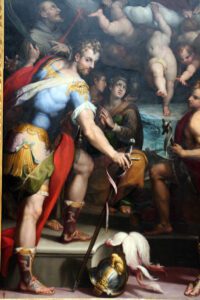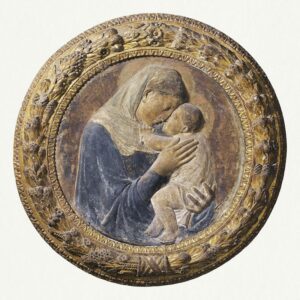The High Renaissance in art is a symphony of balance, harmony, and classical beauty, marking an era where masters like Leonardo da Vinci and Michelangelo redefined artistic genius.
It’s a period where every brushstroke and chisel mark was a deliberate step towards perfection.
We’ll explore the defining characteristics of this golden age and its enduring impact on the art world.
Stay with us as we jump into the masterpieces that still echo the High Renaissance’s revolutionary spirit.
The High Renaissance: A Golden Age Of Art
The High Renaissance marks an epoch of artistic excellence, where innovation met the grandeur of antiquity.
During this period, monumental works were created that would forever reshape the cultural landscape.
We jump into this golden age, recognizing that it wasn’t just about reviving classical standards but imbuing them with a spirit of humanism and realism never before seen.
As artists like Raphael and Titian honed their craft, they introduced techniques that enhanced the depth and emotion in their work.
Their mastery is evident in every detailed composition and vivid portrayal of human expressions.
This was a time where art wasn’t just a process but a conversation between the creator and the observer – an exchange that is as relevant today as it was centuries ago.
Major Contributions to Art:
- Balance and proportion – evident in Leonardo’s The Last Supper,
- Use of light and shadow – Caravaggio’s works serve as prime examples,
- Anatomical accuracy – Michelangelo’s David stands testament to this skill.
This fusion of technique, intellect, and beauty permeated beyond visual arts, influencing literature, philosophy, and even the burgeoning fields of science and exploration.
Painters, sculptors, and architects were not mere craftsmen; they were visionaries who played pivotal roles in the intellectual revolution of their time.
Through our exploration of the High Renaissance, we capture the essence of an era that continues to captivate and inspire.
Its legacy is foundational to our understanding of visual storytelling, influencing not just those who wield the brush but also those behind the camera, telling captivating stories frame by frame.
There’s so much more to unearth about how this illustrious time informs contemporary art and filmmaking, and we’re just scratching the surface.
The Defining Characteristics Of High Renaissance Art
Art during the High Renaissance was distinguished by several key features that set it apart from earlier periods.
We’ll explore some of these characteristics that artists from this era employed to create their timeless masterpieces.
- Harmony and Symmetry – Artists strived for a balance that was pleasing to the eye, an ideal that was heavily influenced by the study of classical antiquity.
- Realism and Expression – There was a focus on making subjects look lifelike, with realistic proportions and emotional expressions that connected with viewers on a personal level.
Artists such as Leonardo da Vinci took realism to new heights.
In The Last Supper, we see the apostles’ reactions to Jesus’ announcement of betrayal.
Their emotions are vivid, their postures diverse, encapsulating the scene’s tension.
- Perspective and Depth – The introduction of linear perspective allowed artists to create the illusion of depth on a flat canvas, making paintings more immersive.
Raphael’s The School of Athens is an exemplary piece that showcases perspective, drawing the viewer’s eye towards the central figures of Plato and Aristotle.
- Use of Light and Shadow – The High Renaissance marked the rise of chiaroscuro, where light and shadow were used to give objects a three-dimensional quality.
Titian’s treatment of light in Assumption of the Virgin elevates the subject matter, highlighting the divine.
This technique became a significant influence on later Baroque artists.
- Classic Motifs and Mythology – High Renaissance art often featured themes from classical mythology and history, aligning with the philosophers’ and humanists’ interests of the time.
Michelangelo’s iconic David is not just a biblical hero; he also represents the ideal human form, a concept inherited from Greek and Roman art.
Our understanding of High Renaissance doesn’t just color our perception of art history; it shapes our approach to modern visual storytelling.
In the film industry, these principles guide cinematographers as they compose shots that evoke emotion and tell a compelling story.
By studying the methods of the masters, we improve our craft, bringing a touch of Renaissance genius to the silver screen.

Leonardo Da Vinci: The Genius Of The High Renaissance
Leonardo da Vinci remains a towering figure in the world of art, embodying the very essence of High Renaissance’s quest for knowledge and beauty.
We know him not only for his paintings but also for his extensive contributions to science, engineering, and anatomy.

His curious mind and desire to understand the world around him led to artistic innovations that were unparalleled at the time.
In our discussion of Leonardo’s influence on the High Renaissance, we’re particularly drawn to The Last Supper and Mona Lisa.
These masterpieces showcase his skillful use of perspective and chiaroscuro – the technique of using strong contrasts between light and dark to give the illusion of three-dimensionality.
The emotional expressions captured in these works reflect the humanist ideals of the period, emphasizing the importance of the individual.
- The Last Supper illustrates Leonardo’s command of perspective and his ability to create a narrative that viewers can instantly connect with.
- Mona Lisa reveals his mastery of the sfumato technique – a delicate gradation of tone that creates a lifelike portrayal.
Leonardo’s notebooks, filled with sketches, scientific diagrams, and ideas, are a testament to his genius.
As a community passionate about visual storytelling, we’re fascinated by how his cross-disciplinary interests influenced his artistic approach.
Filmmakers today can learn from his use of composition and staging to communicate complex emotions and stories effectively.

In exploring his impact on the High Renaissance, we see Leonardo’s legacy not just in his art but in the ways his inventive spirit continues to inspire modern creativity.
His work presents a powerful reminder of the importance of continual learning and interdisciplinary exploration in driving innovation in any artistic Try.
Michelangelo: Unleashing The Power Of Sculpture
As experts in art movements from all eras, we’re captivated by Michelangelo’s groundbreaking contributions during the High Renaissance.
His sculptures, characterized by their vigorous forms and expressive detail, pushed the boundaries of the medium.
Michelangelo saw the act of sculpting as a way to liberate the human form from stone, an idea most poignantly captured in his work David.
This iconic sculpture stands as a testament to Michelangelo’s mastery over marble and his ability to convey intense emotion through form and posture.
In our analysis, we can’t ignore the profound impact of Michelangelo’s Pietà.
The sculpture’s balance of classical beauty with a deeply emotional narrative marks a pivotal moment in art history.
With this piece, Michelangelo not only solidified his reputation as an unparalleled sculptor but also transformed the expectations for religious art.
His detailed attention to the human anatomy combined with a delicate handling of the subjects’ interaction provided a new level of depth to sculptural storytelling.
Michelangelo’s legacy in sculpture extends beyond individual works:
- Precision in anatomy and proportion,
- Emotional depth in expression,
- Evolution of narrative through form.
Each point underscores his lasting influence on the world of art.
His ability to evoke both strength and tenderness through the chisel demonstrated a new potential for sculptures to act as powerful narratives.
The development of this medium during the High Renaissance period owes much to Michelangelo’s visionary approach, an approach that continues to inspire modern creatives across all disciplines.
The Legacy Of The High Renaissance
The High Renaissance was more than a pinnacle of artistic achievement; it planted seeds that would sprout in countless directions for generations to come.
Renaissance principles continue to underpin much of what we recognize as Western art and culture today.
These principles have traversed mediums, influencing not just painting and sculpture but also architecture, literature, and design.
- Architects draw on the symmetry and proportions pioneered by Renaissance masters.
- Literature has been enriched by the themes of humanism and individualism first explored in depth during the Renaissance period.
- Modern design often reflects the blend of functionality and beauty that was a hallmark of Renaissance creativity.
Turning to visual storytelling, we see the direct impact of Renaissance composition and lighting techniques in contemporary filmmaking.
The careful arrangement of subjects and the dramatic use of chiaroscuro can be observed in the works of directors and cinematographers who strive to create a visual language that resonates with depth and emotion.
- Cinematic techniques such as the use of perspective – filmmakers employ this to create a sense of depth and focus in their scenes.
- The dramatic interplay of light and shadow – reminiscent of the techniques used by Caravaggio, continues to be a powerful element in visual storytelling.
also, the High Renaissance’s embrace of multidisciplinary approaches has encouraged modern artists and thinkers to cross traditional boundaries.
Today, we see a fusion of scientific inquiry with artistic expression – mirroring the work of Leonardo da Vinci – in cutting-edge fields like virtual reality and digital animation.
The era’s spirit of innovation and its pursuit of knowledge and beauty resonate in our modern quest for digital expression and immersive experiences.

In education, the study of High Renaissance art offers a template for analyzing cultural achievements from a holistic perspective.
Our understanding of history, social context, and technical mastery is enhanced by examining the works of artists such as Michelangelo and Raphael.
The High Renaissance reminds us of the enduring power of art to reflect the intricacies of the human condition.
What Is High Renaissance In Art – Wrap Up
We’ve explored the High Renaissance, a pivotal era that redefined the art world.
The masterful techniques and intellectual depth of artists like Leonardo da Vinci and Michelangelo set a standard that still resonates in contemporary culture.
Their legacy is evident in the precision and emotional expression found in modern creative fields.
The High Renaissance’s influence extends beyond galleries and museums—it’s woven into the very fabric of our artistic and cultural understanding.
As we reflect on this golden age, we’re reminded of art’s timeless capacity to capture the human spirit.
Frequently Asked Questions
What Are The Defining Characteristics Of High Renaissance Art?
High Renaissance art is characterized by harmony and symmetry, realism and expression, accurate perspective and depth, strategic use of light and shadow, and frequent references to classic motifs and mythology.
Who Was A Major Contributor To High Renaissance Art And What Were Their Notable Works?
Leonardo da Vinci was a significant figure in the High Renaissance period, and his most celebrated paintings include “The Last Supper” and “Mona Lisa,” which exemplify his mastery of perspective, chiaroscuro, and sfumato technique.
What Did Leonardo Da Vinci’s Notebooks Reveal About Him?
Leonardo’s notebooks were filled with sketches and scientific diagrams that revealed his cross-disciplinary interests, showing how his studies in various fields influenced his artistic techniques and approach.
How Did Michelangelo Contribute To Sculpture During The High Renaissance?
Michelangelo revolutionized sculpture with works like “David” and “Pietà,” known for their precise anatomy, proportion, and the ability to evoke strong emotion through form and posture, thereby advancing narrative sculpture.
What Impact Did High Renaissance Art Have On Modern Culture?
High Renaissance art influenced a wide range of areas including architecture, literature, design, and visual storytelling in contemporary filmmaking.
It also informed the integration of scientific inquiry with artistic expression, as reflected in modern fields like virtual reality and digital animation.
How Does The Study Of High Renaissance Art Benefit Contemporary Society?
Analyzing High Renaissance art provides a framework for understanding cultural achievements through a holistic lens, reminding us of the enduring capacity of art to embody complex aspects of the human experience.


